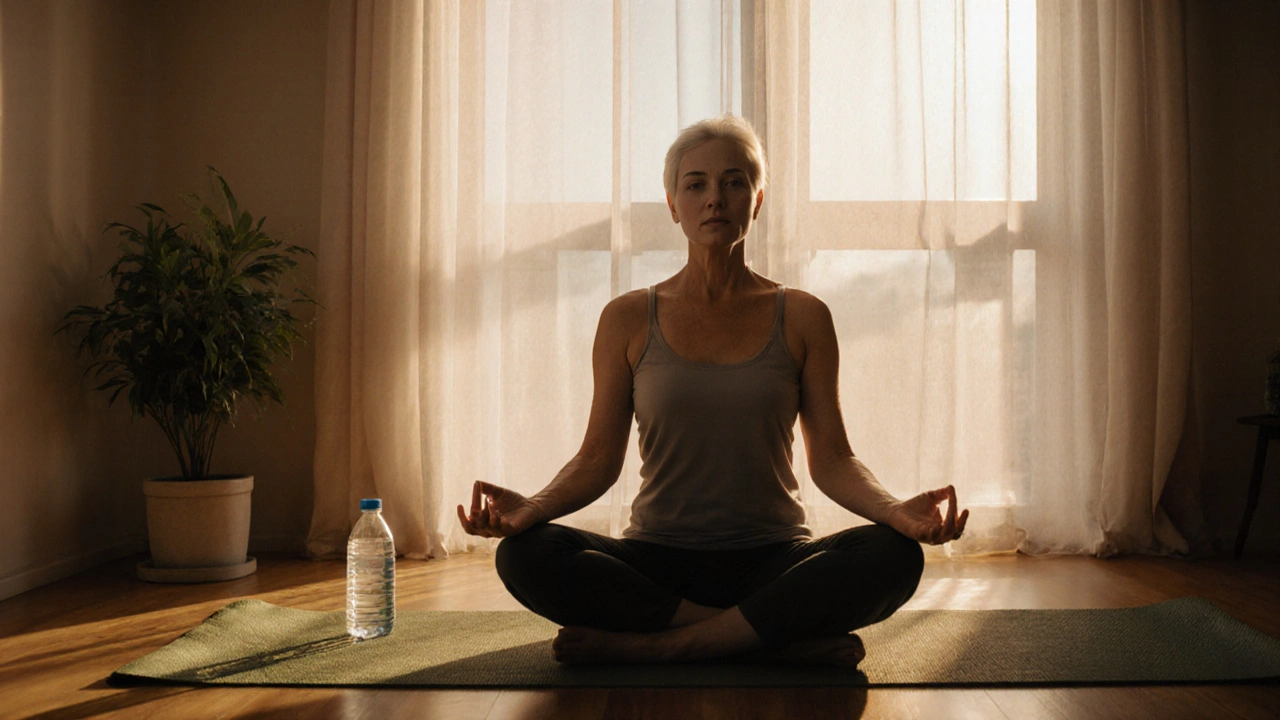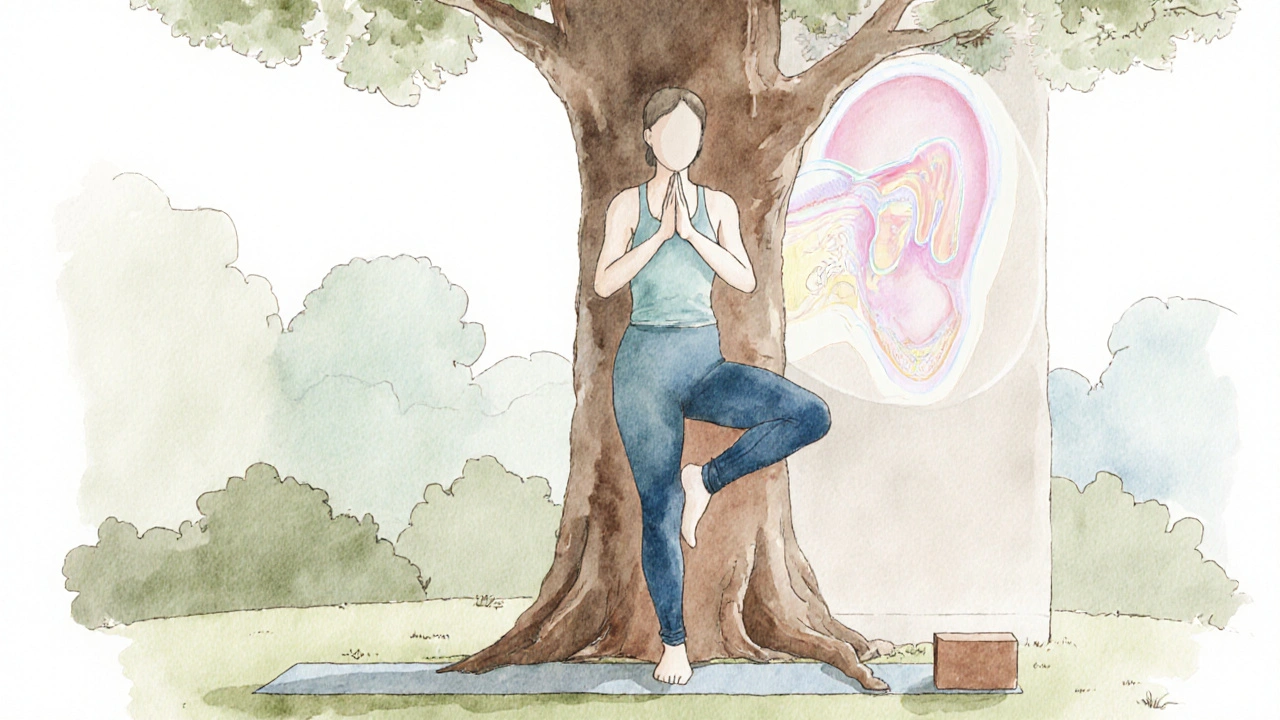How Yoga Helps Manage Vertigo - Benefits & Simple Poses

Yoga for Vertigo: Pose Selector
Tree Pose
Improves unilateral balance and proprioception
30-45 sec each sideHalf-Moon
Engages vestibular receptors while keeping head level
20-30 sec each sideSeated Cat-Cow
Gentle spinal flexion/extension stimulates inner-ear fluid flow
10-15 repsSupported Bridge
Enhances blood circulation to the inner ear and neck
1-2 minNo poses selected yet. Click on poses above to add them to your routine.
Your Personalized Yoga Routine
- Practice 2-3 poses per session, 3 times a week.
- Move slowly and breathe deeply throughout each pose.
- Avoid rapid head movements or inversions.
- Stop immediately if dizziness occurs.
Vertigo can turn everyday tasks into a dizzying nightmare, but you don’t have to rely solely on medication. Yoga a mind‑body practice that blends postures, breath work, and mindfulness offers a gentle, drug‑free way to calm the inner‑ear system and improve balance. If you’re searching for yoga for vertigo, you’re in the right place - we’ll break down why it works and give you a starter routine you can try at home.
Key Takeaways
- Yoga steadies the vestibular system by enhancing proprioception and blood flow.
- Specific poses-like Tree, Half‑Moon, and Seated Cat‑Cow-target balance without triggering vertigo symptoms.
- Consistent practice can reduce the frequency of benign paroxysmal positional vertigo (BPPV) episodes.
- Start slow, focus on breath, and always listen to your body’s warning signs.
- If dizziness persists, combine yoga with professional medical evaluation.
What Is Vertigo and Why It Happens
Vertigo isn’t just “feeling light‑headed.” It’s the sensation that you or your surroundings are spinning. The root cause usually lives in the inner ear-specifically the semicircular canals that feed the brain with balance cues.
One common form, Benign Paroxysmal Positional Vertigo (BPPV), occurs when tiny calcium crystals shift out of place, sending false signals to the brain. The result is brief but intense episodes triggered by head movements.
Other contributors include inflammation, low blood pressure, and reduced proprioception-the body’s sense of position. Improving any of these factors can calm the dizzy spells.
How Yoga Interacts With the Vestibular System
Yoga influences balance through three main pathways:
- Controlled breathing (pranayama) steadies the autonomic nervous system, lowering stress hormones that can aggravate inner‑ear fluid imbalance.
- Gentle movement stimulates the vestibular nuclei, encouraging the brain to recalibrate inaccurate signals.
- Mindfulness sharpens body awareness, helping you notice subtle shifts in equilibrium before they turn into full‑blown spins.
Studies from the Journal of Vestibular Research (2023) showed that a 12‑week yoga program reduced BPPV recurrence by 38% compared with a control group doing standard vestibular rehab.

Core Yoga Poses That Help Calm Vertigo
Below are the safest, most effective asanas for beginners dealing with dizziness. Move slowly, breathe through each transition, and avoid rapid head turns.
| Pose | Targeted Benefit | Suggested Hold |
|---|---|---|
| Tree (Vrksasana) | Improves unilateral balance and proprioception | 30‑45 seconds each side |
| Half‑Moon (Ardha Chandrasana) | Engages vestibular receptors while keeping the head level | 20‑30 seconds each side |
| Seated Cat‑Cow (Marjaryasana‑Bitilasana variation) | Gentle spinal flexion/extension stimulates inner‑ear fluid flow | 10‑15 repetitions |
| Supported Bridge (Setu Bandhasana with bolster) | Enhances blood circulation to the inner ear and neck | 1‑2 minutes |
Start with 2‑3 poses per session, three times a week. As confidence builds, you can add more challenging balances like Eagle or Warrior III, but only under supervision.
Designing a Safe Yoga Routine for Vertigo
Here's a simple 20‑minute flow you can follow on a mat or sturdy carpet:
- Begin with 3 minutes of seated breathing (Dirga Pranayama) - inhale to 4, hold 2, exhale to 6.
- Move into Seated Cat‑Cow for spinal mobility (10 reps).
- Transition to Tree pose, using a wall for support if needed (30s each side).
- Shift into Half‑Moon, using a block under the lower hand for stability (20s each side).
- Finish with Supported Bridge, placing a bolster under the sacrum (1min).
- Close with 2 minutes of seated mindfulness - notice any lingering motion sensations without judgment.
Keep a journal of how you feel before and after each session. Over weeks, you’ll likely notice fewer spin‑triggering moments and a steadier sense of footing.
When to Pause Yoga and Seek Professional Help
Yoga is a powerful adjunct, but it isn’t a cure‑all. If you experience any of these red flags, pause the practice and consult a healthcare provider:
- Sudden loss of hearing or ringing in the ears.
- Vertigo that lasts longer than a minute after a pose.
- Persistent nausea, vomiting, or headache.
- History of neck injury or severe osteoporosis.
In such cases, a vestibular therapist can offer targeted maneuvers (like the Epley repositioning) that complement your yoga routine.
Frequently Asked Questions
Can yoga replace medication for vertigo?
Yoga can reduce the frequency and severity of vertigo episodes, but it usually works best alongside medical treatment, especially for acute BPPV. Always discuss any changes with your doctor.
How often should I practice?
Three short sessions per week are enough to see benefits. Consistency beats intensity for balance training.
Which pose should I avoid?
Rapid inversions or deep head‑standing poses (e.g., Shoulder Stand) can dislodge inner‑ear crystals and worsen BPPV. Stick to level‑ground balances.
Do I need special equipment?
A yoga mat, a sturdy block or a chair for support, and optionally a bolster for Bridge pose are sufficient. No fancy gear required.
Will yoga help other dizziness causes?
Yes. By strengthening core muscles and improving blood flow, yoga can ease low‑blood‑pressure‑related light‑headedness and stress‑induced spells.
12 Comments
Pam Mickelson
Yoga can be a gentle ally for vertigo, especially when you focus on slow, grounded poses and steady breathing. The Tree pose, for example, trains unilateral balance without sudden head movements, and the Half‑Moon keeps the head level while challenging the vestibular system. Incorporating a few mindful breaths between each transition helps calm the nervous system, reducing the likelihood of dizziness. Try holding each side for 30‑45 seconds and notice how your sense of stability improves over time.
Joe V
While the article does a decent job of listing poses, one must wonder why the author neglects to mention the importance of a proper warm‑up. Skipping a brief spinal mobilization can render even the most well‑chosen asanas ineffective, especially for those prone to BPPV. A touch of sarcasm aside, the omission feels like an oversight in an otherwise thorough guide.
Scott Davis
Nice rundown; I’ll start with Tree and Half‑Moon and see how it goes.
Calvin Smith
Honestly, if you think a few minutes of yoga will magically fix vertigo, you’ve been sold a fantasy. Still, a splash of color‑ful balance work does keep the inner ear from feeling like a roller coaster-just don’t overdo it, or you’ll be the punchline of your own joke.
Brenda Hampton
Give it a go and track your progress! Even a short 10‑minute session can shift your equilibrium in the right direction. Consistency beats intensity, so keep the routine simple and celebrate each tiny improvement.
Lara A.
Wow, you really think a few yoga moves will stop the "government" from putting micro‑chips in our vestibular system??! The truth is, they’re using those very poses to calibrate you for their next mind‑control wave-don’t be fooled!!!
Ashishkumar Jain
Hey there! i think yoga is great for vertigo, just remember to move slow and dont rush the poses. the breathing helps calm the nerves and keep the mind focused.
Gayatri Potdar
lol, as if the big pharma ain’t already pushing pills, now these yoga gurus want to brain‑wash us with “mindfulness”. Wake up, folks! The real cure is staying away from their hidden agenda.
Marcella Kennedy
When I first started dealing with vertigo, I felt like the world was constantly tilting beneath my feet, and my confidence took a serious hit. I was hesitant to try anything that might exacerbate the spinning sensation, so I approached the idea of yoga with cautious optimism. The first step was to find a quiet space where I could sit comfortably without distractions; I set up a yoga mat, a sturdy block, and a bolstered chair for support. I began each session with three minutes of Dirga Pranayama-inhale for four counts, hold for two, and exhale for six-letting the breath anchor me to the present moment. This simple breathing exercise dramatically lowered my heart rate and calmed the nervous system, making the subsequent movements feel safer.
Next, I introduced Seated Cat‑Cow, moving gently for ten to fifteen repetitions. The slow flexion and extension of the spine encouraged a subtle flow of inner‑ear fluid, which seemed to reduce the intensity of my dizziness over time. I then progressed to Tree pose, using a wall for balance at first. Holding each side for thirty seconds while focusing on a fixed point helped retrain my proprioceptive feedback without triggering vertigo.
Half‑Moon came next, supported by a block under the lower hand. By keeping the head level and the gaze steady, I engaged the vestibular receptors without sudden head tilts. The pose felt challenging yet rewarding, and after several weeks I noticed my episodes became less frequent. Finally, I settled into Supported Bridge, placing a bolster under my sacrum for one minute. The gentle inversion encouraged blood flow to the neck and inner ear, completing a well‑rounded routine.
Throughout these weeks, I kept a simple journal, noting any pre‑session symptoms, how I felt during each pose, and post‑session observations. Patterns emerged: consistent practice three times a week correlated with a noticeable decline in spin‑triggering moments, and on days when I skipped the breathing portion, my head felt more unstable. By paying attention to these subtle cues, I could adjust the intensity of my practice and avoid over‑exertion.
It’s also worth mentioning that I consulted with my vestibular therapist, who confirmed that my yoga routine complemented the standard Epley maneuvers they had taught me. The combined approach accelerated my recovery, allowing me to return to daily activities with confidence. If you’re considering yoga for vertigo, start slow, honor your body’s limits, and remember that the goal is steady, sustainable progress rather than rapid perfection.
Jamie Hogan
Interesting perspective, though brevity often conveys depth.
Ram Dwivedi
👍 Adding to the discussion, I’d suggest incorporating a brief meditation after the poses-just five minutes of seated mindfulness can reinforce the neural pathways you’re training. Over time, this can lead to lasting improvements in balance and reduced vertigo frequency. 🌟
pooja shukla
Don't listen to foreign “experts”; the real solution is to follow traditional Indian practices and keep our cultural heritage alive-nothing beats the ancient methods passed down through generations.






Write a comment